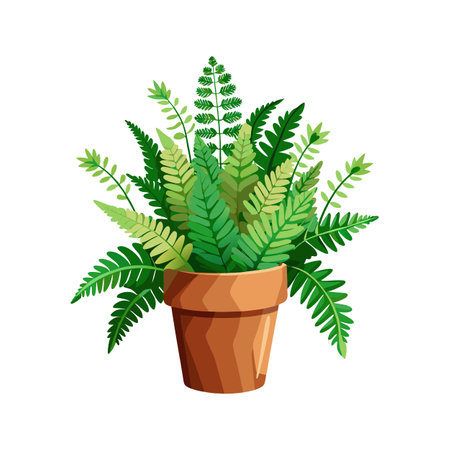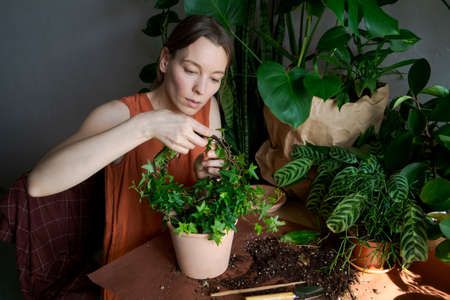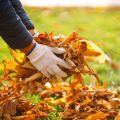Common Indoor Plant Pests
Even the healthiest indoor plants can occasionally fall victim to pests. Knowing how to spot and identify the most common bugs is the first step in keeping your houseplants thriving. Here are some of the most frequent indoor plant pests you might encounter in homes across the U.S., along with signs to watch for:
Spider Mites
Spider mites are tiny, often red or brown, and are hard to see with the naked eye. They thrive in dry indoor environments and spin fine webbing under leaves. If your plants leaves look speckled or dull and you see thin webs, spider mites could be the culprit.
Fungus Gnats
These small black flies resemble fruit flies and are commonly found hovering around the soil surface. Fungus gnats lay eggs in moist potting soil, and their larvae feed on organic matter and sometimes plant roots, which can stunt growth in young plants.
Mealybugs
Mealybugs appear as white, cotton-like masses usually found on stems, leaf joints, and undersides of leaves. They suck sap from your plants and can cause yellowing or dropping leaves. Theyre slow-moving but can quickly multiply if not treated.
Aphids
Aphids are small, soft-bodied insects that come in green, black, or gray. They cluster on new growth and stems, sucking plant juices and excreting a sticky substance called honeydew, which can attract mold or ants.
Scale Insects
Scale insects look like small brown or tan bumps attached to stems or leaf surfaces. These pests have a protective shell-like covering and also feed on plant sap. Infestations often go unnoticed until plants start to decline.
Quick Reference Table: Common Indoor Plant Pests
| Pest | Appearance | Common Signs | Where to Look |
|---|---|---|---|
| Spider Mites | Tiny red/brown dots; webbing | Speckled leaves; fine webs | Underside of leaves |
| Fungus Gnats | Small black flies | Flying near soil; stunted growth | Soil surface; around pots |
| Mealybugs | White cottony clumps | Sticky residue; yellowing leaves | Leaf joints; stems; undersides of leaves |
| Aphids | Tiny green/black/gray bugs | Curling leaves; sticky honeydew | New growth; stems; buds |
| Scale Insects | Brown/tan shell-like bumps | Dull or dropping leaves; sap loss | Stems; underside of leaves |
If you notice any of these signs on your houseplants, its important to take action early before an infestation spreads. Catching pests early makes organic treatment methods more effective and helps protect your entire indoor garden.
2. Early Detection and Monitoring
Keeping a close eye on your indoor plants is one of the best ways to catch pest problems before they get out of hand. With regular monitoring and a few simple tools, you can spot trouble early and take action using organic methods. Heres how to stay ahead of pests without using harsh chemicals.
Routine Inspections
Make it a habit to check your plants at least once a week. Look closely at both the top and bottom of leaves, stems, and even the soil surface. Early signs of pests may include small holes, sticky residue, webbing, or discolored spots. Don’t forget to inspect newly purchased plants before bringing them indoors, as they can introduce unwanted bugs.
Recognizing Common Symptoms
Different pests leave different clues. Knowing what to look for can help you identify issues faster. Heres a quick guide:
| Pest Type | Common Signs |
|---|---|
| Aphids | Sticky leaves, distorted growth, clusters on new shoots |
| Spider Mites | Fine webbing, yellow speckled leaves |
| Fungus Gnats | Tiny flies around soil, larvae in moist potting mix |
| Mealybugs | Cotton-like clumps on stems and leaf joints |
| Scale Insects | Brown or tan shell-like bumps on stems or undersides of leaves |
Using Sticky Traps
Sticky traps are an easy and chemical-free way to monitor flying pests like fungus gnats or whiteflies. Place yellow sticky cards just above the plant canopy or near the base of the plant. Check the traps regularly to see if theres increased pest activity.
Magnifiers for Close Inspection
A handheld magnifying glass or a jeweler’s loupe can help you spot tiny pests like spider mites that are hard to see with the naked eye. These tools are especially useful when youre unsure if symptoms are caused by pests or other issues like nutrient deficiencies.
Helpful Tips for Better Monitoring
- Inspect plants during daylight hours when visibility is better.
- Keep a journal or take photos to track changes over time.
- Quarantine any infested plant away from others immediately.
Catching pest problems early makes treatment easier and more effective—especially when youre sticking with organic solutions. A little attention each week goes a long way toward keeping your indoor garden healthy and pest-free.

3. Natural Preventive Measures
Keeping your indoor plants healthy and pest-free starts with prevention. Using organic methods not only protects your plants but also keeps your home environment safe and chemical-free. Below are some simple, natural strategies to prevent pest infestations before they become a problem.
Proper Plant Care
Healthy plants are less likely to attract pests. Start with the basics:
- Watering: Overwatering or underwatering can stress plants, making them more susceptible to pests. Always check the soil moisture before watering.
- Lighting: Make sure each plant gets the right amount of light. Some need bright direct sun, while others prefer low light.
- Soil: Use high-quality organic potting mix suited for your plant type. Avoid reusing old soil that may harbor pests or eggs.
Adequate Air Circulation
Good airflow helps prevent mold and discourages pests like fungus gnats and spider mites. Here’s how to improve air circulation indoors:
- Space out plants so air can move freely between them.
- Use a small fan in rooms with many plants, especially during humid months.
- Avoid overcrowding plants on windowsills or shelves.
Quarantine New Plants
Bringing a new plant home? Always isolate it for at least two weeks before placing it near your other houseplants. This helps ensure it’s not carrying any hidden pests.
| Step | Why It Helps |
|---|---|
| Inspect leaves and soil | Catches visible pests like aphids or mealybugs early |
| Keep in separate room | Prevents possible pest spread to other plants |
| Monitor for signs of stress or bugs | You’ll notice issues before they spread |
Regular Inspection Routine
Create a habit of checking your plants weekly. Look under leaves, around stems, and in the soil for any unusual signs like webbing, sticky residue, or tiny insects moving around. Catching issues early is key to keeping your plants healthy the natural way.
Tip:
If you spot something odd, try wiping leaves with a damp cloth or spraying with a mix of water and mild liquid soap (make sure its organic and safe for plants).
By taking these preventive steps, youll create a healthier indoor garden thats naturally resistant to pests—no harsh chemicals required!
4. Organic Treatment Options
When indoor plants face pest problems, its important to address them in a way that’s safe for both your home and the environment. Organic treatments are a great option because they avoid harsh chemicals while still effectively managing common pests like spider mites, aphids, fungus gnats, and mealybugs. Here are some tried-and-true organic solutions you can use at home.
Neem Oil
Neem oil is extracted from the seeds of the neem tree and works as a natural insecticide. It disrupts pests’ hormones, making it harder for them to grow and reproduce. Neem oil is especially effective against soft-bodied insects like aphids and whiteflies.
How to Use:
- Mix 2 teaspoons of neem oil with 1 teaspoon of mild liquid soap in 1 quart of warm water.
- Shake well and spray directly on affected leaves and stems once a week.
Insecticidal Soap
This is a specially formulated soap that kills pests by breaking down their outer coating. It’s gentle on most houseplants but deadly to many common bugs.
How to Use:
- You can buy ready-made insecticidal soap or make your own by mixing 1 tablespoon of mild liquid soap (like Castile soap) in 1 quart of water.
- Spray directly onto infested areas every few days until pests are gone.
Diatomaceous Earth (DE)
Diatomaceous earth is a fine powder made from fossilized algae. It damages the exoskeletons of crawling insects like ants and fungus gnats, causing them to dehydrate and die.
How to Use:
- Sprinkle a thin layer over the surface of the potting soil where pests may be hiding.
- Reapply after watering or when the powder becomes less visible.
Homemade Remedies Using Household Ingredients
You can also create simple, effective pest control sprays using items already in your kitchen. These remedies are easy to make and safe around kids and pets.
| Remedy | Main Ingredients | Target Pests | Instructions |
|---|---|---|---|
| Garlic Spray | Garlic, water, mild soap | Aphids, spider mites | Blend 1 bulb of garlic with 2 cups of water, strain, add a few drops of soap, and spray weekly. |
| Cinnamon Powder | Cinnamon spice | Fungus gnats (larvae) | Sprinkle cinnamon on top of the soil to prevent fungal growth that attracts gnats. |
| Apple Cider Vinegar Trap | Apple cider vinegar, dish soap | Fungus gnats, fruit flies | Place vinegar with a drop of dish soap in a small bowl near plants to attract and trap pests. |
Using organic methods not only helps protect your indoor plants but also keeps your living space free from harmful chemicals. With just a few ingredients and regular care, you can tackle most indoor pest problems naturally and effectively.
5. Long-Term Pest Management
Keeping indoor plants healthy over time means being proactive, not just reacting when pests show up. Long-term pest management focuses on creating a balanced environment where pests are less likely to thrive. This includes using Integrated Pest Management (IPM), adding beneficial insects when needed, and sticking to a regular plant care routine.
What is Integrated Pest Management (IPM)?
Integrated Pest Management, or IPM, is a natural approach that combines several methods to prevent and control pests without relying on harsh chemicals. The goal is to keep pests at low levels while protecting your plants and the environment. IPM includes monitoring for early signs of pests, improving plant care, and using organic controls only when necessary.
Key Steps in an Indoor IPM Plan:
| Step | Description |
|---|---|
| Monitor Regularly | Check leaves, soil, and stems weekly for signs of pests like webbing, sticky residue, or holes. |
| Identify Pests | Correctly identify whats causing the problem so you can choose the right organic method. |
| Improve Plant Health | Healthy plants resist pests better. Ensure proper light, water, and airflow. |
| Cultural Controls | Avoid overwatering and overcrowding plants to reduce humidity and hiding spots for bugs. |
| Use Organic Treatments | If needed, use neem oil, insecticidal soap, or diatomaceous earth as safer alternatives. |
Introducing Beneficial Insects Indoors
You might not think about bugs as helpers inside your home, but some beneficial insects can actually help manage pest populations naturally. These tiny allies feed on common houseplant pests like aphids, spider mites, and whiteflies.
Common Beneficial Insects for Indoor Use:
| Insect | Pests They Control |
|---|---|
| Lacewing Larvae | Aphids, mealybugs, thrips |
| Ladybugs (Ladybird Beetles) | Aphids, scale insects |
| Predatory Mites | Spider mites and other small pests |
You can buy these insects online or from specialty garden stores. Be sure your indoor climate supports their survival—moderate humidity and temperature are key. Also avoid using sprays that could harm them after release.
Create a Consistent Maintenance Routine
A big part of long-term pest prevention is simply taking good care of your plants every week. A consistent routine helps catch problems early and keeps your indoor garden strong.
Your Weekly Plant Care Checklist:
- Inspect all plants closely for early signs of pests.
- Wipe down leaves with a damp cloth to remove dust and bugs.
- Trim off dead or yellowing leaves to improve airflow.
- Avoid overwatering—let soil dry out between watering unless the plant prefers moist soil.
- Rotate pots occasionally so plants get even sunlight exposure.
- Sterilize tools like pruning shears before using them on different plants.
This kind of regular attention makes it much easier to spot potential issues early—and take action before a full-blown infestation begins.
By combining smart prevention through IPM, introducing natural predators if needed, and giving your plants steady care each week, you’ll build a healthier indoor ecosystem where pests have a much harder time settling in.


